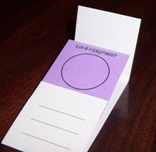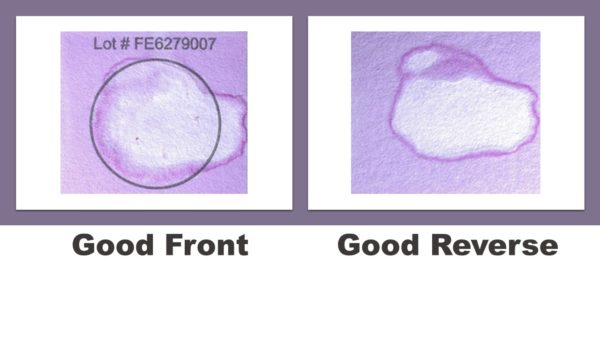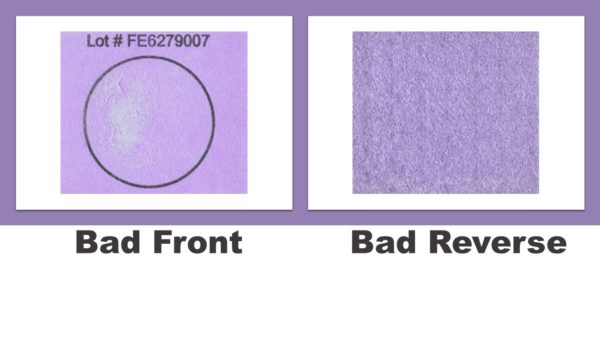FTA Cards (Foam-Tipped Applicators) are designed to capture and bind DNA samples for future processing. Please follow the directions below to obtain an optimal sample. Instructions are also included in the test kit.
Foam tipped applicator swabs are used to collect the sample from the dog, and are then used to apply the sample to the FTA card. The dog’s saliva carries the cheek cells (where the DNA is coming from) from the dog’s cheek to the FTA card. When applying the sample from the swab to the card, enough sample should be collected in order to allow it to soak through the card. Following a successful application, the purple shaded area will fade and change color. The color change should be visible both on the front AND the reverse side of the card. If the card does not change color, it is indicative of a poor sample with insufficient DNA for processing. If the card does not change color, it is OK to reswab the dog and reapply the sample to the same card – however, if doing so, please insure that the swab does not become compromised by coming in contact with DNA from another animal. See the examples displaying both good and bad collection results.

Organize first – There should be 1 FTA card (in a small manila envelope), 1 sterile foam tipped applicator swab and 1 test order form containing bar-code and address labels for each individual to be sampled. A second person to handle the dog while you collect the sample and apply it to the card is very useful, and reduces possibility for contamination.
Dogs being swabbed should not have had anything to eat or drink for about an hour prior to collecting the sample. With adult dogs, pick up chew bones, rawhides, and any other toys or treats that contain anything that had been living at some point. If testing young puppies, wake them from a nap, collect the sample, and return them to their mother after you are done. You will need a clean table-top surface to let each card dry safely for about 1 hour (no wind, and as little dust or other material in the air as possible).

Instructions
- Open the swab. It is VERY IMPORTANT that you do not touch the swab to anything except the mouth of the individual being sampled, and do not touch any of the treated surface of the FTA card (the colored circle and surrounding colored area). Hold the card only by the white untreated area of the card.
- Open the dog’s mouth and rub the swab along the inside of the cheek for 5 to 10 seconds. Scrub the cheek with force similar to what you would use if brushing the dog’s teeth so the swab picks up many cheek cells.
- Squeeze the swab onto the circle on the card, using pressure to transfer the cells and saliva on the swab to the card. Do not scrub or push so hard that you damage the surface of the card. You can fold the lid of the card over the swab and squeeze it. As it dries, the card will change color from purple to whitish wherever DNA has transferred. You should see this color change and this color change should soak all the way through to the back side of the purple card. If there is no color change, you may need to swab the dog again, making sure to rub the cheek long enough to pick up cells and saliva. If the dog is very dry-mouthed, touch the swab to its tongue once or twice, remove the swab from its mouth and let the dog smack its lips a few times, then try swabbing again. Usually this will cause them to salivate enough to get a good sample.
- Allow the card to dry at room temperature for 1 hour. If you have multiple cards to test several dogs, be sure that the cards are not touching each other at any time.
- Return each card to its own envelope. Do not put anything else in the envelope with the card. The cards do not need to be refrigerated or frozen – the DNA on them is very stable at room temperature. You do not need to return the foam tipped applicator swab.
- Ship to the University of Missouri. The cards are very stable and can be sent by regular mail or in the overnight/priority envelopes supplied by shippers. A return shipping label to the University of Missouri is provided on the order form.

